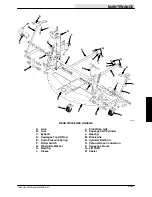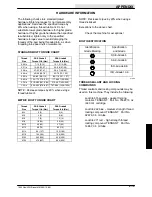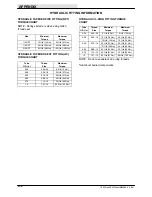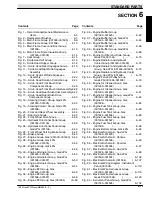
MAINTENANCE
1550 Gas/LPG/Diesel MM283 (9--01)
3--50
BRAKES AND TIRES
SERVICE BRAKES
The service brakes are hydraulically activated by
a master brake cylinder.
Check the master brake cylinder fluid level after
every 400 hours of operation and add brake fluid
as needed. The master brake cylinder is located
at the front of the machine. Open the front
compartment door for access to the master
cylinder.
If necessary, adjust brake linkage as follows:
adjust clevis on master cylinder push rod so that
brake pedal is in a horizontal position when the
cylinder push rod starts to engage the cylinder
piston.
C
B
A
D
F
G
E
00105
BRAKE SYSTEM COMPONENTS
A. Brake Pedal
B. Shaft
C. Pin
D. Master Brake Cylinder
E. Brake Line
F. Push Rod
G. Clevis
Brakes require bleeding whenever air enters the
system, lowering the effective braking pressure.
Air can enter when the master cylinder or wheel
cylinders are serviced or if the fluid in the
reservoir runs dry. Air can also enter through a
leaky brake line or hose. Find the leaking line and
replace it before bleeding.
Whenever handling brake fluid, do not get any on
the brake pads, brake discs, calipers, or body
paint. Brake pads will be permanently damaged,
requiring replacement. Body paint can be
damaged also unless you wipe the area with a
clean cloth and wash it with a soapy solution
immediately.
1. Make sure that the brake fluid reservoir is
full and that the vent in the cap is open.
2. Connect a plastic or rubber tube to the
bleeder valve on the left front wheel.
Suspend the other end of the tube in a jar or
bottle filled with a few inches of brake fluid.
During the remaining steps, keep this end
submerged at all times and never let the
level in the brake fluid reservoir drop below
one half full.
3. Open the bleeder valve and plug on the left
front wheel about one turn. Have an
assistant press the brake pedal slowly to the
floor. As soon as the pedal is all the way
down, close the bleeder valve and let the
pedal up. Repeat this step as many times as
necessary, until fluid with no air bubbles
exits from the tube.
4. Bleed the right front wheel in the same
manner as described in the steps above.
Keep checking the brake fluid reservoir to be
sure it doesn’t run out of fluid.
5. When all wheels are bled, discard the brake
fluid in the jar or bottle; never reuse such
fluid.
6. Top up the brake fluid reservoir with clean
fluid.
Summary of Contents for 1550
Page 16: ...SPECIFICATIONS 1550 Gas LPG Diesel MM283 6 91 1 2 ...
Page 100: ...APPENDIX 1550 Gas LPG Diesel MM283 6 91 4 2 ...
Page 112: ...STANDARD PARTS 1550 Gas LPG Diesel MM283 11 07 6 6 ...
Page 237: ...STANDARD PARTS 6 131 1550 Gas LPG Diesel MM283 3 11 ...
Page 286: ...STANDARD PARTS 1550 Gas LPG Diesel MM283 8 02 6 180 ...
Page 301: ...LPG PARTS 7 15 1550 Gas LPG Diesel MM283 11 07 ...
Page 363: ...DIESEL PARTS 8 53 1550 Gas LPG Diesel MM283 2 05 ...
Page 378: ...DIESEL PARTS 1550 Gas LPG Diesel MM283 2 05 8 68 ...
Page 436: ...BREAKDOWNS 1550 Gas LPG Diesel MM283 8 02 10 38 ...
Page 456: ...CONTINENTAL ENGINE BREAKDOWN GASOLINE LPG 1550 Gas LPG Diesel MM283 2 95 11 20 ...
Page 534: ...PERKINS ENGINE BREAKDOWN DIESEL 1550 Gas LPG Diesel MM283 9 01 15 30 ...
Page 562: ...1011676 CAT ENGINE BREAKDOWN DIESEL 1550 Gas LPG Diesel MM283 2 05 16 28 ...
















































